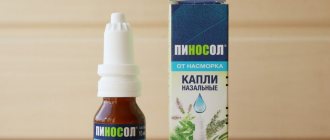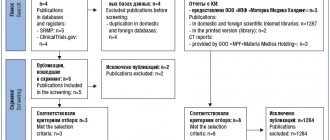Compound
Ambroxol tablets contain 30 mg of ambroxol hydrochloride as an active component and excipients: lactose monohydrate , corn starch (Amylum maidis), microcrystalline cellulose (Cellulose microcristallic), stearate (Magnesium stearate), dioxide silicon (Silicii dioxydum).
5 ml of Ambroxol syrup contains 15 mg of ambroxol hydrochloride and a number of other ingredients: sodium benzoate (E211, Sodium benzoate), propylene glycol, glycerin (Glycerinum), sodium saccharin (Saccharin sodium), sorbitol (E420 ; Sorbitol), hydroxyethylcellulose (Hydroxyethylcellulose), citric acid monohydrate (Citric acid monohydrate), flavors (apricot, raspberry, orange), menthol (Mentholum), purified water (Aquae purificati).
pharmachologic effect
The drug belongs to the group of mucolytic drugs and is used as an expectorant for diseases affecting the respiratory tract .
It stimulates the motor function of the respiratory tract and has a pronounced secretolytic and expectorant effect .
Stimulates the formation of sputum ( tracheobronchial tree secretion ) of reduced viscosity due to changes in the structure of sputum mucopolysaccharides and increases the production of glycoproteins (thus exerting a mucokinetic effect ).
While taking Ambroxol, the motor activity of ciliated cilia of epithelial tissue and the transport of pathogenic agents of the mucociliary system .
An important property of the drug is its ability to increase the amount of pulmonary surfactant ( anti-atelectic factor ), which maintains surface tension, uniformity of configuration, volume and compliance indicators of the lungs.
In addition, thanks to Ambroxol, the breakdown of surfactant and its synthesis and secretion is enhanced in large alveolar cells ( type II alveolar pneumocytes ), which are involved in the transport of fluids through the alveolar-capillary system .
The peculiarity of the drug is that, while reducing the viscosity of sputum, it practically does not provoke an increase in its volume, and, thus, does not cause those negative effects that develop while taking expectorants. a liquefying effect on sputum by disrupting the integrity of the disulfide bonds of acidic mucopolysaccharides and the sputum gel.
In accordance with OKPD (all-Russian product classifier), Ambroxol code is 24.42.13.723.
Pharmacodynamics and pharmacokinetics
Ambroxol helps normalize the function of the serous and mucosal glands located in the bronchial mucosa , helps reduce the number of cystic cavities in the mucous membrane and stimulates the production of the serous component without causing bronchial obstruction .
Research results indicate that after treatment with the drug in patients with bronchial obstruction, the ventilation function of the lungs significantly improves, and the severity of symptoms of hypoxemia decreases.
There is also data that allows us to conclude that the drug has an immunomodulatory effect : it strengthens local immunity by activating tissue mononuclear phagocytes and increasing the production of secretory immunoglobulin of the IgA class .
Ambroxol suppresses the production of TNF and interleukin 1 by mononuclear phagocytes , which are mediators of inflammation, and also helps to enhance the natural defense of the lungs by increasing the activity of macrophages .
It has also been proven that Ambroxol is capable of having anti-edematous and anti-inflammatory effects , effectively relieves the symptoms of exacerbated chronic bronchitis and prevents the development of idiopathic pulmonary fibrosis .
Some authors report that in in vitro models, Ambroxol is able to inhibit neutrophil chemotaxis .
Ambroxol is absorbed quite quickly and completely through any route of administration, penetrating well into the lung tissue. The plasma concentration of the substance reaches its maximum within two hours after taking the drug per os.
The biotransformation process occurs in the liver . Metabolic products are glucuronides and dibromanthranilic acid .
About 90% is excreted from the body in the urine in the form of water-soluble metabolites ; About 5% is excreted unchanged.
T1/2 - from 10 to 12 hours. It increases in patients with severe forms of renal failure , but remains unchanged in patients with impaired liver function .
Ambroxol and antibacterial therapy
It is especially important to note that ambroxol potentiates the effect of antibiotics. The first evidence that ambroxol hydrochloride increases the concentration of antibacterial drugs in bronchoalveolar secretions and lungs was obtained under experimental conditions. It was shown that the average concentrations of ampicillin, erythromycin and amoxicillin in the lungs of rats receiving the antibiotic + ambroxol were 23, 27 and 27% higher, respectively, than in rats receiving only the antibiotic. The differences in all cases were statistically significant (p < 0.05) [7]. The results of a double-blind, placebo-controlled study conducted in 1987 showed that ambroxol, when administered in combination with these antibacterial drugs, leads to an increase in the rate of passive diffusion of antibiotics from the blood plasma into the lung tissue without changing their concentrations in the blood plasma [16].
A similar effect was found for other β-lactam antibiotics, including cephalosporins, as well as ofloxacin [17, 18]. It was assumed that the joint administration of drugs increases the adsorption of the antibiotic in the intestine, but in a number of studies this hypothesis was not confirmed. Moreover, this effect was also observed with parenteral administration of antimicrobial drugs. A number of authors consider this phenomenon as a consequence of increased permeability of the vasobronchial barrier or increased evaporation of fluid from less viscous secretions [20, 21]. The use of ambroxol in combination with antibiotics (ampicillin, erythromycin, doxycycline, cefuroxime) in patients with pneumonia showed that in the comparable time frame the X-ray picture returned to normal in 79% of patients compared to 53% of patients receiving only antibiotics.
Regardless of the degree to which we understand the mechanisms of this phenomenon, clinical and experimental data are sufficient to confirm the indicated effects of ambroxol, which is without a doubt one of the outstanding properties of this drug [21–29].
Ambroxol and surfactant
Another equally important feature of ambroxol is its ability to stimulate the production of surfactant [4, 29]. Pulmonary surfactant is an antiatelectasis factor; it lines the inner surface of the alveoli in the form of a thin film and ensures the stability of alveolar cells during breathing, protects them from unfavorable factors, helps regulate the rheological properties of bronchopulmonary secretions, improves its “sliding” along the epithelium and facilitates the release of sputum from the respiratory tract. Ambroxol is able to increase the amount of surfactant, increasing its synthesis and inhibiting its breakdown in alveolocytes of the second order. This makes it possible to widely use this drug for respiratory distress syndrome. Ambroxol is used to prevent distress syndrome when there is a threat of premature birth starting from the 28th week of pregnancy and for the treatment of distress syndrome in premature infants. The possibility of using ambroxol by pregnant women and children in the first 3 weeks of life, including premature infants, is due to its high safety indicators. Being one of the components of the local lung defense system, surfactant prevents the penetration of pathogenic microorganisms into epithelial cells. Surfactant also enhances the activity of the cilia of the ciliated epithelium, which, in combination with improving the rheological properties of bronchial secretions, leads to effective cleansing of the airways, helping the patient to cough well [30–34].
Antioxidant activity of ambroxol
Previously, among mucolytics, only acetylcysteine was considered as a drug with antioxidant properties. Recent studies demonstrate the presence of antioxidant activity in ambroxol [35–37].
Of course, the antioxidant effect will expand the indications for wider use of ambroxol not only for respiratory diseases, but also for a number of other pathologies.
Thus, summing up the above, it can be argued that ambroxol has the following range of beneficial therapeutic effects:
Liquefies stagnant viscous sputum, reduces the amount and viscosity of secretions. Accelerates mucus transport by increasing the frequency of movements of the villi of the ciliated epithelium. Increases the penetration of antibiotics into foci of infection in the respiratory tract. Stimulates the formation of endogenous surfactant. Prevents exacerbations of chronic lung diseases. It has a preventive effect against the development of bronchopulmonary diseases during surgical interventions on the chest and upper gastrointestinal tract. Has antioxidant properties.
Bibliography
Cough. Understanding and treating a problem with many causes. American College of Chest Physicians, 2000. Ovcharenko S.I. Cough: etiology, diagnosis, treatment approaches. Consilium Medicum. 2006;8(1):552–57. Chuchalin A.G. Respiratory diseases. Medical newspaper. 2000;43. Mashkovsky M.D. Medicines. Kharkov: Torsing, 1997. Novikov Y.K., Belevsky A.S. Mucolytics in the complex treatment of COPD. Attending doctor. 2001;2: https://www.osp.ru/doctore/2001/02/062.htm Volkov I.K., Lukina O.F., Tylo O.V., Kushelevskaya O.V. The place of mucolytic therapy in the treatment of chronic lung diseases in children. Pediatrics. 2005;7(1). Chuchalin A.G., Knyazheskaya N.P., Kravchenko N.Yu. Place of the mucolytic drug Lazolvan (ambroxol) in clinical practice. Russian medical journal. 2005;26:1736–39. Knyazheskaya N.P., Chuchalin A.G. Rationale for choosing a drug for the treatment of cough syndrome and diseases accompanied by sputum production. Russian medical journal. 2007;15(18):1–4. Knyazheskaya N.P., Bobkov E.V. Expectorant drugs in the practice of an internist. Features of the drug Lazolvan (ambroxol). Directory of a polyclinic doctor. 2012;2:43–7. Melillo G., Cocco G. Ambroxol decreases bronchial hyperreactivity. Eur. J. Respira. Dis. 1986;69:316–20. Bianchi M., Mantovani A., Erroi A., Dinarello CA, Ghezzi P. Ambroxol inhibits interleukin 1 and tumor necrosis factor production in human mononuclear cells. Agents Actions. 1990;31(3–4):275–79. Gibbs BF, Schmutzler W., Vollrath IB Ambroxol inhibits the release of histamine, leukotrienes and cytokines from human leukocytes and mast cells. Inflamm. Res. 1999;48(2):86–93. Su X., Wang L., Song Y., Bai C. Inhibition of inflammatory responses by ambroxol, a mucolytic agent, in a murine model of acute lung injury induced by lipopolysaccharide. Intensive Care Med. 2004;30(1):133–40. Peroni DG, Moser S, Gallo G, et al. Ambroxol inhibits neutrophil respiratory burst activated by alpha chain integrin adhesion. Int. J. Immunopathol. Pharmacol. 2013;26(4):883–87. Wang Y., Su NX, Chen ZQ, Wang Z., Zhang SF Effects of Fengbaisan on the expression of matrix metalloproteinase-9 and tissue inhibitor of metalloproteinase-1 in lung tissue of rats with chronic obstructive pulmonary disease. Chin. J. Integr. Med. 2013 Nov 16. . Spatola J, Poderoso JJ, Wiemeyer JC, et al. Influence of amoroxol on lung tissue penetration of amoxicilin. Arzneimittelforschung. 1987;37(8):956–66. Neria JP, Rubi EG Response to the combination of ambroxol/amoxicillin versus amoxicillin alone in patients with acute respiratory infections. Comparative study of antibiotic levels in bronchial mucus and plasma. Compend. Invest. Clin. Lat. Am. 1992;12(1):5–10. Braga PC. Antibiotic penetrability into bronchical mucus: Pharmacokinetics and Clinical considerations. Curr. Therap. Res. 1991;49(2):300–27. Paganin F., Bouvet O., Chanez P., et al. Evaluation of the effects of ambroxol on the ofloxacin concentrations in bronchial tissues in COPD patients with infectious exacerbation. Biopharm. Drug Dispos. 1995;16:393–401. Gene R, Poderoso JJ, Corazza C, et al. Influence of Ambroxol on amoxycillin levels in broncho-alveolar lavage fluid. Arzneimittelforschung. 1987;37(8):967–68. Belal FF, Sharaf El-Din MK, El-Enany NM, Saad S. Micellar liquid chromatographic method for the simultaneous determination of Levofloxacin and Ambroxol in combined tablets: Application to biological fluids. Chem. Cent. J. 2013;7(1):162. doi:10.1186/1752-153X-7-162. Barsic B., Klinar I., Strugar-Suica J. Azithromycin in the treatment of acute exacerbation of chronic bronchitis: a meta-analysis, ICMASKO 6. Program and abstracts, Bologna, Italy, January 23–25. 2002:189. Principi N., Zavattini G. Possibility of interaction among antibiotics and mucolytics in children. Int. J. Pharm. Res. 1986;6(5):369–72. Wiemeyer JCM Influence of ambroxol on broncho-pulmonary levels of antibiotics. Arzneimittelforschung. 1981;31(1):974–76. Harnett J., Wilson J. Effectiveness of Azithromycin in patients with community-aquired pneumonia: an evidenced-based meta-analysis of randomized controlled trials. In: ICMASKO 6. Program and abstracts. Bologna, Italy, January 23-25, 2002:177. Bonnetti P. Ambroxol plus amoxicillin versus amoxicillin alone in various respiratory tract infections. Investig. Medica International. 1993;20:99–103. Peralta J., Poderoso JJ, Corazza C., et al. Ambroxol plus amoxicillin in the treatment of exacerbations of chronic bronchitis. Arzneimittelforschung. 1987;37:969–71. Chang CC, Cheng AC, Chang AB Over-the-counter (OTC) medications to reduce cough as an adjunct to antibiotics for acute pneumonia in children and adults. Cochrane Database Syst. Rev. 2012;2:CD006088. doi: 10.1002/14651858.CD006088.pub3. Gao X., Huang Y., Han Y., Bai CX, Wang G. The protective effects of Ambroxol in Pseudomonas aeruginosa-induced pneumonia in rats. Arch. Med. Sci. 2011;7(3):405–13. Ma YT, Tian YP, Su JL, et al. Influence of ambroxol on paraquat-induced lung tissue injury and change in pulmonary surfactant-associated protein A in the experimental rats. Zhonghua Lao Dong Wei Sheng Zhi Ye Bing Za Zhi. 2006;24(6):348–51. Chinese Kimya Y., Kucukkomurcu S., Ozan H., Uncu G. Antenatal ambroxol usage in the prevention of infant respiratory distress syndrome. Beneficial and adverse effects. Clin. Exp. Obstet. Gynecol. 1995;22:204–11. Laoag-Fernandez JB, Fernandez AM, Maruo T. Antenatal use of ambroxol for the prevention of respiratory infant distress syndrome. J. Obstet. Gynaecol. Res. 2000;26:307–12. Wauer RR, Schmalisch G., Bohme B., Arand J., Lehmann D. Randomized double blind trial of Ambroxol for the treatment of respiratory distress syndrome. Eur. J. Pediatr. 1992;151:357–63. Weinmann H.-M. Ambroxol in pediatrics. Therapieworche. 1981;31:7940–47. Lee CS, Jang YY, Song JS, et al. Ambroxol inhibits peroxynitrite-induced damage of alpha1-antiproteinase and free radical production in activated phagocytic cells. Pharmacol. Toxicol. 2002;91(3):140–49. Huang J., Xu J., Tian L., Zhong L. A thioredoxin reductase and/or thioredoxin system-based mechanism for antioxidant effects of ambroxol. Biochimie. 2014;97:92–103. . Sanders A., Hemmelgarn H., Melrose HL., et al. Transgenic mice expressing human glucocerebrosidase variants: utility for the study of Gaucher disease. Blood Cells Mol. Dis. 2013;51(2):109–15. [Epub 2013 Apr 30]. About the authors / For correspondence N.P. Knyazheskaya – Candidate of Medical Sciences, Associate Professor of the Department of Pulmonology, Federal Educational Institution of Higher Professional Education, Russian National Research Medical University named after. N.I. PirogovMinistry of Health of Russia
Indications for use: what are Ambroxol tablets for and what is Ambroxol in syrup form for?
It is known that the viscosity, elasticity and adhesiveness of sputum determine how easily it is separated and expectorated.
Therefore, mucolytic drugs are especially useful for diseases of the respiratory system , conditions that are accompanied by the formation and accumulation in the bronchi and lungs of viscous, poorly separated mucous or purulent-mucous sputum .
Indications for use of Ambroxol are:
- obstructive bronchitis (in acute and chronic forms);
- pneumonia;
- tracheitis;
- constrictive bronchiolitis;
- laryngitis;
- rhinitis;
- cystic fibrosis;
- bronchial asthma;
- pharyngitis;
- atelectasis , developed as a result of mucoid blockage of the bronchi , in patients with a tracheostomy tube , etc.;
- respiratory distress syndrome (shock lung) in adults;
- respiratory distress syndrome (RDS) in newborn infants (including children born prematurely) and other diseases associated with impaired bronchial secretion and accompanied by increased formation of viscous mucus.
Use of the drug for alcoholism
The medicine is not used directly in the treatment of chronic alcoholism. Its components cannot cope with the strong, painful addiction to alcohol.
If a person drinks alcoholic beverages daily, then mucolytic is contraindicated for him for the following reasons:
- There will be an excessive pharmacological load on the body, because the drug will still not have a therapeutic effect.
- The consequences of such treatment will be digestive disorders, drowsiness, and lethargy.
In people with alcohol dependence, toxic ethanol products constantly circulate in the systemic bloodstream. Therefore, reception is possible only at the stage of complete abstinence from alcohol.
Patients with chronic alcoholism suffer from many pathologies due to a persistent decrease in immunity, including respiratory immunity. The use of a mucolytic in complex therapy will come in handy.
Sources
- https://lechimbolez.ru/ambroksol-i-alkogol-mozhno.html
- https://MyWeak.ru/alkogolizm/lekarstva/ambroksol-sovmestimost.html
- https://www.VIDAL.ru/drugs/ambroxol-bv
- https://drugs.medelement.com/drug/%D0%B0%D0%BC%D0%B1%D1%80%D0%BE%D0%BA%D1%81%D0%BE%D0%BB-15 -%D0%B8%D0%BD%D1%81%D1%82%D1%80%D1%83%D0%BA%D1%86%D0%B8%D1%8F/867150351605181836?instruction_lang=RU
- https://bz.medvestnik.ru/drugs/1402.html
- https://drugs.medelement.com/drug/%D0%B0%D0%BC%D0%B1%D1%80%D0%BE%D0%BA%D1%81%D0%BE%D0%BB-30 %D0%BC%D0%B3-%D0%B8%D0%BD%D1%81%D1%82%D1%80%D1%83%D0%BA%D1%86%D0%B8%D1%8F/ 184241071477650943?instruction_lang=RU
[collapse]
Contraindications
The drug is not used to treat patients with hypersensitivity to one or more of its components, as well as women in the first 13 weeks of pregnancy.
Ambroxol tablets are contraindicated in patients diagnosed with gastric and duodenal ulcers (the drug may affect the clinical picture of these diseases), as well as in the case of the development of epileptic syndrome of various natures.
An additional contraindication for syrup is hereditary fructose intolerance.
Ambroxol is contraindicated for dry cough , which usually accompanies influenza and other acute respiratory viral infections .
The most dangerous combinations and consequences
The combination of alcohol and chemical-based drugs can lead to serious disorders in the body, and in some cases to fatal consequences.
List of medications and their side effects in combination with alcohol:
| Name of group, drug | Negative results of interaction |
| Neuroleptics (tranquilizers, anticonvulsants, hypnotics) | Severe intoxication, up to cerebral coma |
| CNS stimulants (Theophedrine, Ephedrine, Caffeine) | Rapid increase in blood pressure, hypertensive crisis |
| Antihypertensives (Captofrin, Enalapril, Enap-N), diuretics (Indapamide, Furosemide) | Sudden drop in pressure, collapse |
| Analgesics, anti-inflammatory | Increased toxic substances in the blood, general poisoning of the body |
| Acetylsalicylic acid (Aspirin) | Acute gastritis, perforation of gastric ulcer and 12-PC |
| Paracetamol | Toxic liver damage |
| Hypoglycemic (Glibenclamide, Glipizide, Metformin, Phenformin), insulin | A sharp decrease in blood sugar levels, hypoglycemic coma |
Side effects
Adverse reactions associated with taking Ambroxol are rare. The drug is non-toxic and well tolerated by patients.
In some cases, the body may respond to treatment with dyspeptic symptoms , skin rash , angioedema , allergic reactions , general weakness, and headache .
Isolated cases of the development of serious skin lesions ( Lyell's disease or Stevens-Johnson disease ) have also been recorded. Most likely, they are explained by the severe course of the disease or the reaction of a particular organism to the simultaneous use of several drugs.
Adverse reactions and overdose
Side effects after taking the drug appear extremely rarely. Ambroxol has no toxic effect and is well absorbed in the human body.
In rare cases, skin problems may occur, manifested by a rash, as well as allergies, angioedema, lethargy and headache.
When taken simultaneously with incompatible drugs, isolated cases of severe skin lesions have been recorded.
In case of overdose, the patient experiences vomiting, nausea, and diarrhea. If such symptoms appear, you need to induce vomiting and rinse the stomach as quickly as possible. Then for a couple of days you need to eat food that contains fats.
Instructions for use of Ambroxol
Ambroxol tablets: instructions for use
Ambroxol hydrochloride tablets are intended for oral administration. They should be taken with a small amount of liquid.
The recommended dose for adult patients and children over the age of twelve is 30 mg (one tablet). The frequency of doses is 2 (if necessary, the drug can be taken 3 times a day).
In case of exacerbation of chronic diseases, the dose of Ambroxol in tablets is doubled (up to 60 mg). The frequency of doses is 2 times a day.
Cough tablets are used to treat children over six years of age. The therapeutic dose for children from six to twelve years of age is from 1.2 to 1.6 mg/kg/day in 3 divided doses.
The duration of treatment is determined individually depending on the severity of the disease and the patient’s response to therapy. As a rule, it ranges from 10 to 14 days.
Ambroxol syrup: instructions for use
For all categories of patients over twelve years of age, during the first 2-3 days of the disease, the recommended dose is 10 ml (equivalent to the volume of two teaspoons). Then the treatment is continued, taking the syrup 3 times a day. 5 ml (equivalent to the volume of one teaspoon).
Syrup for children is dosed depending on the age of the child. Thus, children aged five to twelve years are recommended to take 5 ml of syrup (30 mg of active ingredient per day) 2 times a day. If necessary, the frequency of doses is increased to 3 (the daily dose of ambroxol in this case is 45 mg).
Children aged two to six years are prescribed to take 2.5 ml of syrup 3 times a day; children under two years old - 2.5 ml of syrup 2 times a day. This is equivalent to 22.5 and 15 mg of active ingredient per day, respectively.
If the patient is indicated for long-term treatment, the dose may be halved.
Instructions for Ambroxol: dosage regimen of Abroxol for inhalation, as well as solution for injection and infusion
Adult patients are prescribed one or two inhalations per day using 3 ml of inhalation solution; Children over 5 years of age are recommended to take one inhalation per day using 2 ml of solution (equivalent to 15 mg of the active substance).
If the drug is prescribed in the form of an injection solution, the optimal dose for an adult patient is from 30 to 60 mg/day. Divide it into three administrations. The maximum single dose is 30 mg.
Typically, the solution is injected into a vein or muscle, although subcutaneous administration is also acceptable. For shock lung syndrome, the dose of ambroxol is 10 mg/kg/day. The drug should be administered 3 or 4 times a day. In cases where it is appropriate, the daily dose is increased to 30 mg/kg. It is administered in 3-4 doses.
Cautions, therapy monitoring
Isolated cases of severe skin lesions such as Stevens-Johnson syndrome and Lyell's syndrome (toxic epidermal necrolysis) have been reported with the use of mucolytic agents such as ambroxol hydrochloride. They could mainly be explained by the severity of the underlying disease and/or concomitant therapy. In addition, at the initial stage of Stevens-Johnson syndrome or Lyell's syndrome, patients may experience flu-like nonspecific prodromal symptoms, such as fever, body pain (aches), rhinitis, cough, sore throat. As a result of their misjudgment, patients may have received medications for the symptomatic treatment of coughs and colds. For this reason, if skin and/or mucous membrane lesions appear when using Ambroxol 15, you should immediately stop taking the drug and seek medical help. The drug should be used with caution in patients with gastric and/or duodenal ulcers. In case of impaired renal function or severe liver disease, Ambroxol 15 should be used only after consulting a doctor; it is possible to lengthen the intervals between doses or reduce the dose of the drug.
Ambroxol hydrochloride is metabolized in the liver and excreted from the body by the kidneys, therefore, in severe renal failure, accumulation of ambroxol and/or its metabolites in the liver is possible. During treatment, it is necessary to consume enough liquid (juices, tea, water) to enhance the mucolytic effect of the drug. The drug contains sorbitol. Patients with rare hereditary problems of fructose intolerance should not take this drug. Sorbitol may also cause a mild laxative effect.
Ambroxol 15 does not contain sugar, so it can be used by patients with diabetes. Does not contain alcohol. Ambroxol 15 with antitussive drugs leads to impaired sputum discharge while reducing cough. With increased secretion of mucus, with impaired bronchomotor functions (for example, with such a rare genetically determined disease as primary ciliary dyskinesia), mucolytic agents (including ambroxol) should be used with caution due to the risk of possible accumulation of large amounts of mucus. It is necessary to consult a doctor before using the drug in children under 2 years of age.
Interaction
The use of Ambroxol in combination with antibiotics helps to increase the concentration of the active substance of the latter in the bronchial mucosa and pulmonary alveoli , which in turn improves the clinical situation with bacterial infections of the lungs .
The combination of a drug with antibiotics of an antibiotic alone , even in cases where the effectiveness of an antibacterial drug .
Ambroxol enhances the effect of Ampicillin , Amoxicillin , and Theophyllinum and promotes their better penetration into bronchial secretions .
No antagonistic interactions of the drug with diuretics and cardiac glycosides .
The use of Ambroxol with drugs that suppress the cough reflex significantly complicates the discharge of sputum while reducing the intensity of the cough .
The drug is compatible with drugs that are used to slow down labor.
special instructions
To purchase medicine at a pharmacy you do not need a doctor's prescription. Shelf life – 3 years. Do not use after expiration date. Store at room temperature.
When using mucolytic drugs, it is advisable to drink as much liquid as possible: tea, compote, juices.
Patients with bronchial asthma should take a bronchodilator before inhalation to prevent irritation of the respiratory tract.
Taking tablets and syrup in parallel with antibiotics increases the content of the active component of the latter in the lung mucosa, which has a positive effect on the patient’s condition.
Analogs
Level 4 ATX code matches:
Mukolik
Abrol
Ambrosan
Bronchorus
ACC 100
ACC 200
ACC Long
ACC
Mukolwan
Lazolvan
Bromhexine 8
Bromhexine 8 Berlin-Chemie
Bromhexine
Bronchobos
Carbocisteine
Erdomed
Pulmozyme
Pectolvan C
Halixol
Ambrobene
Analogues of Ambroxol are the drugs Ambrobene , Ambrohexal , Ambroxol-Vial , Ambroxol-Zdorovye , Ambroxol-Vishfa , Ambroxol-Darnitsa , Lazolvan , , Bronkhoxol , Neo-Bronchol , Halixol , Medox , etc.
Which is better: Ambroxol or Bromhexine? What are these pills for?
The active ingredient Ambroxol is an active metabolite of bromhexine hydrochloride (a substance that is a synthetic analogue of the alkaloid vasicine ). At the same time, the therapeutic effectiveness of Ambroxol is an order of magnitude higher than that of its predecessor.
In addition, Ambroxol is better tolerated by patients, has virtually no contraindications (even infants and pregnant women can take it), and side effects from its use develop extremely rarely.
Ambroxol for children
The most common childhood diseases are diseases of the bronchi and lungs , which are usually accompanied by stagnation of sputum in the bronchi . Timely excretion of sputum is an indispensable condition for the normal functioning of the respiratory system , as well as the key to their recovery from diseases.
Ambroxol syrup for children is one of the latest developments in the field of pharmacy. Like other dosage forms of Ambroxol, the drug has proven itself to be an effective remedy for sputum , so pediatricians recommend it for the treatment of even very young patients.
The dose and dosage form of the drug for children is selected depending on age (the dose varies from 15 mg to 45 mg per day).
Ambroxol during pregnancy
During pregnancy , the drug is contraindicated only in the first trimester. In the second and third trimesters, it is allowed to be prescribed, taking into account the benefits for the expectant mother and the potential risks for the developing fetus.
On forums, many are interested in why doctors recommend this particular drug during pregnancy. There is evidence that in cases where a woman takes tablets or syrup during pregnancy , the synthesis of pulmonary surfactant .
Interesting results were noted when using the drug in the treatment of respiratory system in unborn children. The ability of the drug to pass well through the placental barrier allows it to be used in cases where the child, for one reason or another, begins to accumulate mucus in the bronchi or lungs .
If treatment with the drug is necessary during breastfeeding , the issue of stopping the latter should be decided, since the active substance Ambroxol is excreted in milk.
Overdose
At this time, specific symptoms of ambroxol overdose are unknown. In case of accidental overdose and/or erroneous use, symptoms consistent with the side effects of ambroxol hydrochloride may be observed.
Treatment is symptomatic.
special instructions
Since Ambroxol tablets contain lactose, patients with rare hereditary galactose intolerance, Lapp lactose deficiency or glucose-galactose malabsorption should not take this drug. When prescribing Ambroxol to patients with impaired renal function and/or severe liver disease, careful medical supervision is required. In such cases, it is recommended to reduce the dose and/or increase the time between doses.
Use during pregnancy and lactation
Ambroxol is contraindicated in the first trimester of pregnancy. The use of Ambroxol in the second or third trimester of pregnancy is possible only after a preliminary assessment of the ratio of the expected benefit to the mother and the possible risk to the fetus. Ambroxol is excreted into breast milk and is therefore contraindicated for use during breastfeeding.
Features of the effect of the drug on the ability to drive a vehicle or potentially dangerous mechanisms
Reviews about Ambroxol
The drug Ambroxol is a very popular drug that allows you to effectively treat respiratory diseases . It normalizes the functioning of bronchial cilia , thins accumulated mucus and activates its elimination.
The use of an inhalation solution, injection solution, syrup or Ambroxol tablets - reviews are proof of this - enhances the formation of an agent that clears mucus from the bronchi and lungs, and also prolongs its action.
Reviews of Ambroxol syrup indicate that this drug has virtually no drawbacks. It effectively eliminates unpleasant symptoms of the disease, relieves inflammation and stimulates the synthesis of immunoglobulin , which in turn helps strengthen local immunity.
Another advantage of the drug is its price - both tablets and syrup for children belong to the category of inexpensive medicines.
Ambroxol price
The average price of Ambroxol in tablet form in Ukraine is 3.8 UAH. The price of Ambroxol syrup is from 11 to 75 UAH (depending on the manufacturer). The cost of the inhalation and oral solution also varies depending on which pharmaceutical company makes it.
The average price of Ambroxol tablets in Russia is 20 rubles; syrup for children can be purchased for an average of 30-50 rubles per bottle.
- Online pharmacies in RussiaRussia
- Online pharmacies in UkraineUkraine
- Online pharmacies in KazakhstanKazakhstan
ZdravCity
- Ambroxol tablets 30 mg 20 pcs. Ozone LLC
37 rub. order - Ambroxol solution for internal use. approx. and ing 7.5mg/ml 100mlOzon LLC
RUB 144 order
- Ambroxol-Hemofarm syrup 15mg/5ml 100mlHemofarm A.D. Vršac, branch Production site Šabac
96 RUR order
- Ambroxol-Akrikhin tab. 30 mg 20 pcs. JSC "AKRIKHIN"
118 RUR order
- Ambroxol Renewal tab. 30mg 20pcs JSC "PFK Obnovlenye"
117 RUR order
Pharmacy Dialogue
- Ambroxol-ALSI (tab. 30 mg No. 30) Alsi Pharm
44 RUR order
- Ambroxol (syrup 15mg/5ml 100ml)Hemofarm
84 rub. order
- Ambroxol (tab. 30 mg No. 20) Ozone LLC
34 RUR order
- Ambroxol (tab. 30 mg No. 20) TCPP
27 RUR order
- Ambroxol Welfarm (tab. 30 mg No. 30) Welfarm LLC
RUB 131 order
show more
Pharmacy24
- Ambroxol 30 mg tablets PrAT" Pharmaceutical company "Darnitsa", Ukraine
11 UAH. order - Ambroxol syrup 30 mg/5 ml 100 ml PAT NEC "Borshchagivsky chemical and pharmaceutical plant", Kiev, Ukraine
27 UAH order
- Ambroxol 30 mg No. 20 tablets Ternopharm TOV, Ternopil, Ukraine
7 UAH order
- Ambroxol 0.03 g No. 20 tablets PAT NEC "Borshchagivsky chemical and pharmaceutical plant", Kiev, Ukraine
7 UAH order
- Ambroxol 0.03 g No. 20 tablets PAT "Khimpharmzavod" Chervona Zirka", Kharkov, Ukraine
8 UAH order
PaniPharmacy
- Ambroxol liquid Ambroxol forte syrup 30mg/5ml 100ml Ukraine, Zdorovye LLC
31 UAH order
- Ambroxol liquid Ambroxol syrup 15mg/5ml 100ml Ukraine, Borshchagovsky Chemical Plant PJSC
27 UAH order
- Ambroxol tablets Ambroxol tablets. 0.03g No. 20 Ukraine, Lekhim-Kharkov CJSC
8 UAH order
- Ambroxol liquid Ambroxol syrup 15mg/5ml 100ml Ukraine, Ternopharm LLC
23 UAH order
- Ambroxol tablets Ambroxol tablets. 0.03g No. 20 Ukraine, Kiev Vitamin Plant PJSC
12 UAH order
show more






